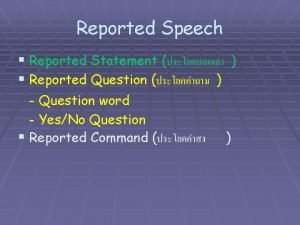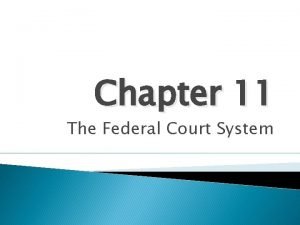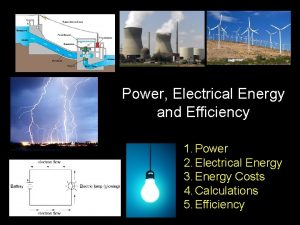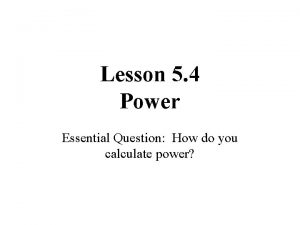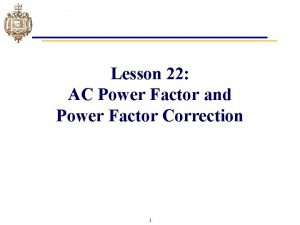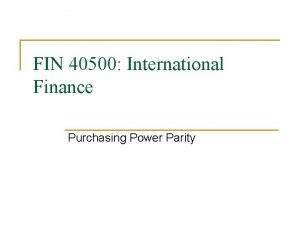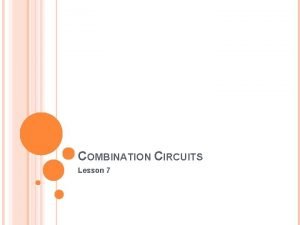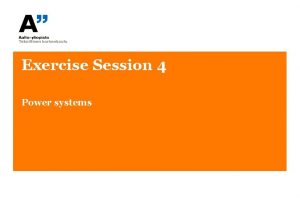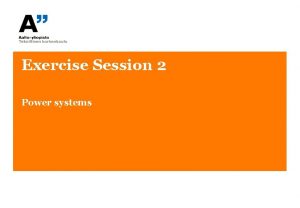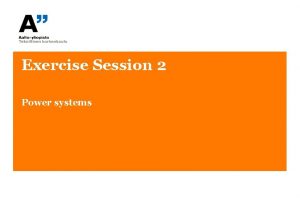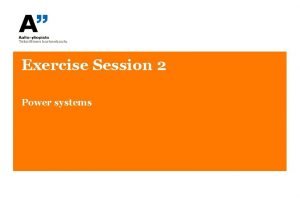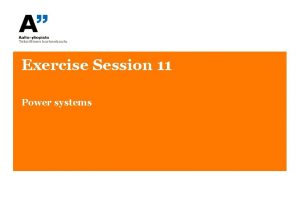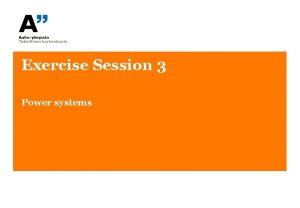Exercise Session 4 Power systems Question 1 Calculate

















- Slides: 17

Exercise Session 4 Power systems

Question 1 • Calculate the maximum active power Pmax that can be transferred from busbar 1 to busbar 2 using the voltages shown in the picture.

Question 1 The equivalent scheme of the line, using reactances for P. U. computation.

Question 1

Power-angle equation: Question 1 The highest power that can be transmitted: Maximum value when:

Question 2 The power that can be transferred by a line is, usually, limited by the reactive power resources. A line has a series reactance X=100 and the voltage at the beginning of the line is U 1=115 k. V. The reactive power at the end of the line is Q 2=0. Derive the expressions for power transferred and reactive power Q 1 as the function of voltage angle . How much smaller is the maximum transferred power compared to a case where the necessary reactive power could be fed to the end of the line?

Question 2 Power-angle equation:

Question 2

Question 2

Question 3: (for help, see Power System Analysis by Grainger, ch. 16 or other book) • A generator having an inertia constant of H = 6. 0 MJ/MVA is delivering power of 1. 0 per unit to an infinite bus through a purely reactive network when the occurrence of a fault reduces the generator output to zero. The maximum power that could be delivered is 2. 5 per unit. When the fault is cleared, the original network conditions again exist. Determine the critical angle and critical clearing time.

Question 3: critical clearing angle P 2. 5 A 2 1 Pi A 1 = A 2, Stability Criterion δ

Question 3: critical clearing time P 2. 5 From lecture slides Multiply by 4 and Divide by ω A 2 1 Pi A 1 δ

Question 4 A 60 -Hz generator is supplying 60% of Pmax to an infinite bus through a reactive network. A fault occurs which increases the reactance of the network between the generator internal voltage and the infinite bus by 400%. When the fault is cleared, the maximum power that can be delivered is 80% of the original maximum value. Determine the critical clearing angle for the condition described.

Question 4: (for help, see Power System Analysis by Grainger, ch. 16 or other book) Power-angle curve A before a fault, B during the fault, and C after the fault such that A = Pmax sin δ, B =k 1 A, and C = k 2 A, with k 1 < k 2. For stability, we must have area A 1 = area A 2. Note: picture illustrative - not from the problem

Question 4: Determine the critical clearing angle In our case: Before the fault: During the fault: After the fault:

Question 4: Determine the critical clearing angle A = Pmax sin δ, B =k 1 A, and C = k 2 A. For stability, we must have area A 1 = area A 2.

Question 4: Determine the critical clearing angle Using the previously derived equations:
 Costas level
Costas level An exercise session has three stages
An exercise session has three stages Draw the power triangle
Draw the power triangle Daily 10/4 keller williams
Daily 10/4 keller williams Tag question rules
Tag question rules He said to me what are you doing
He said to me what are you doing Tag questions i am
Tag questions i am What court helps congress exercise its power
What court helps congress exercise its power Flower power privilege
Flower power privilege How to calculate work and power
How to calculate work and power How to calculate electrical power
How to calculate electrical power A motor driven winch pulls the 50 kg student
A motor driven winch pulls the 50 kg student Power triangle
Power triangle Ppp rate formula
Ppp rate formula Calculating purchasing power parity
Calculating purchasing power parity How to calculate purchasing power parity
How to calculate purchasing power parity How to calculate purchasing power parity
How to calculate purchasing power parity Calculating combination circuits
Calculating combination circuits





